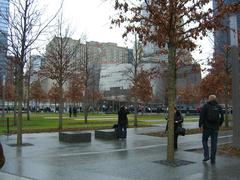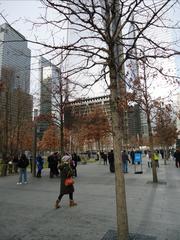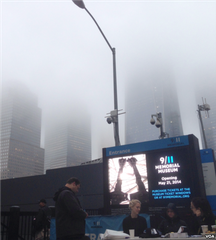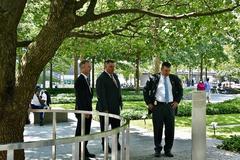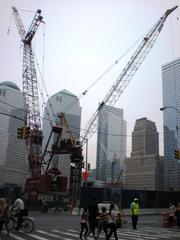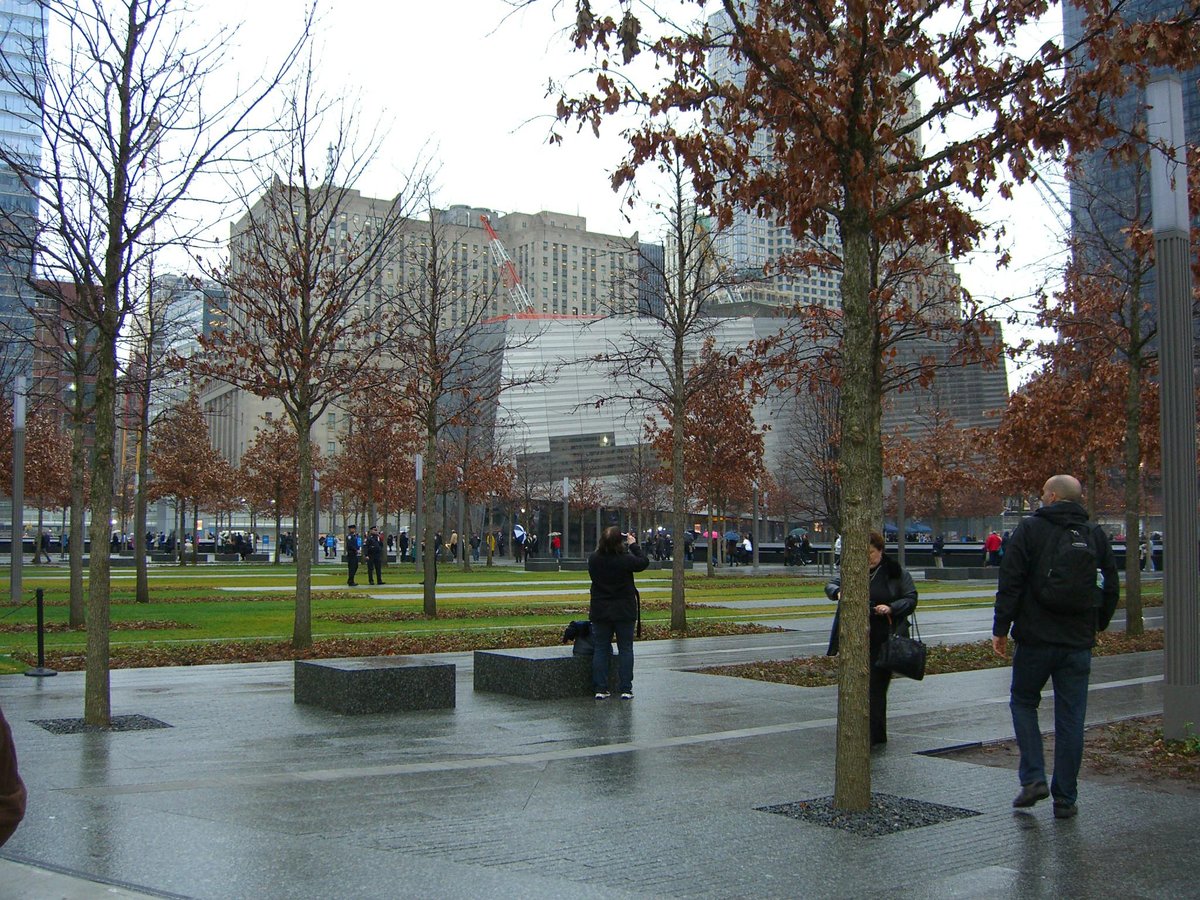
National September 11 Memorial & Museum
National September 11 Memorial & Museum: Comprehensive Visiting Guide
Date: 14/06/2025
Introduction
The National September 11 Memorial & Museum stands as a solemn tribute to the nearly 3,000 victims of the September 11, 2001 terrorist attacks and the 1993 World Trade Center bombing. Located at the original World Trade Center site in Lower Manhattan, this landmark is both a place of remembrance and a center for education and reflection. Its powerful design—anchored by twin reflecting pools, bronze name parapets, and the Survivor Tree—offers an immersive experience that honors loss, resilience, and hope. This guide details everything you need to know for a meaningful and respectful visit, including hours, ticketing, accessibility, site highlights, and visitor tips (9/11 Memorial & Museum official website).
Table of Contents
- Historical Background and Significance
- Design and Architecture
- Memorial Features
- Museum Layout and Exhibits
- Visiting Hours and Tickets
- Accessibility and Visitor Services
- Transportation and Directions
- Nearby Attractions
- Visitor Tips
- Frequently Asked Questions (FAQ)
- Conclusion
Historical Background and Significance
In response to the tragic events of September 11, 2001, and the earlier 1993 World Trade Center bombing, the National September 11 Memorial & Museum was conceived as a place for reflection, commemoration, and education. The project began with the establishment of the World Trade Center Memorial Foundation in 2003, which later became the National September 11 Memorial & Museum. After a global design competition, the winning design, “Reflecting Absence” by Michael Arad and Peter Walker, was selected for its emotive power and architectural restraint (WikiArquitectura; ArchDaily).
The memorial opened on September 11, 2011, marking the tenth anniversary of the attacks, and the museum followed in 2014. Today, the site stands as a symbol of resilience and unity, drawing millions of visitors annually from around the world.
Design and Architecture
”Reflecting Absence” Concept
The memorial’s design is grounded in the theme of absence, using the original footprints of the Twin Towers to create two massive reflecting pools. These pools are the largest man-made waterfalls in North America, with water cascading down into a central void—an evocative symbol of loss (ArchDaily).
Memorial Plaza
Covering eight acres, the Memorial Plaza features over 400 swamp white oak trees, providing shade and an atmosphere conducive to reflection. The Survivor Tree, a Callery pear rescued from the debris, stands as a living symbol of resilience (9/11 Memorial - Survivor Tree).
Sustainability and Accessibility
The Memorial Plaza is LEED Gold certified, featuring stormwater collection for irrigation and energy-efficient lighting. Gentle slopes and ramps ensure the site is fully accessible for all visitors (WikiArquitectura).
Memorial Features
- Reflecting Pools: Two nearly one-acre pools, each set in the footprints of the Twin Towers, surrounded by bronze parapets inscribed with the names of 2,983 victims from the 2001 and 1993 attacks (WikiArquitectura).
- Survivor Tree: A Callery pear tree that survived the attacks and was replanted, now thriving as a symbol of hope (9/11 Memorial - Survivor Tree).
- Memorial Glade: Six large stone monoliths honor those who have suffered or died due to exposure to toxins in the aftermath of 9/11 (9/11 Memorial Glade).
- White Roses: Placed daily on victim names to mark birthdays, a touching gesture of remembrance.
Museum Layout and Exhibits
Location and Flow
The museum is located at 180 Greenwich Street, with most of its 110,000 square feet of exhibition space situated below ground at the bedrock level of the original towers (911memorial.org). Visitors descend from street level, setting a contemplative tone.
Core Exhibitions
- Historical Exhibition: Chronicles the events before, during, and after 9/11 through images, artifacts, personal stories, and multimedia presentations (Condé Nast Traveler).
- In Memoriam: Honors each victim with photographs and biographies, along with personal audio recordings of tributes (WhichMuseum).
- FDNY Memorial Wall: Dedicated to the 343 firefighters who lost their lives, inscribed with the quote: “Bravery is the defender of all other virtues” (CityPASS).
- Artifacts: Includes the Ladder 3 firetruck, Survivors’ Staircase, steel beams, and personal effects (History Hit).
- Memorial Hall: Features a steel-forged quote: “No day shall erase you from the memory of time.”
- Interactive Displays: Archival audio, video, and digital timelines provide layered perspectives on the events (Condé Nast Traveler).
Special Installations
- Tribute in Light: On each anniversary, twin beams of light illuminate the night sky, visible for miles as a powerful symbol (The Tour Guy).
Visiting Hours and Tickets
Memorial
- Hours: Daily, 8:00 a.m. – 8:00 p.m. (911memorial.org)
- Admission: Free and open to the public; no ticket required.
Museum
- Hours: Wednesday–Monday, 9:00 a.m. – 7:00 p.m. (last entry 5:30 p.m.); closed most Tuesdays (911memorial.org).
- Tickets: Timed-entry tickets are required. Standard adult admission is $33 (2025), with discounts for seniors, students, children, and free admission for children under 7 (Loving New York).
- Free Admission: New York residents with valid ID on Tuesday evenings, and all visitors on Mondays from 5:30–7:00 p.m., with limited tickets (The Globetrotting Teacher).
- Purchase: Reserve tickets in advance online (911memorial.org).
Accessibility and Visitor Services
- Fully Wheelchair Accessible: Ramps, elevators, and accessible restrooms are available throughout the site (911memorial.org).
- Service Animals: Permitted inside the museum (The Better Vacation).
- Audio Guides: Available in eight languages, including American Sign Language.
- Security: Airport-style screening required for museum entry; large bags are not allowed.
- Facilities: Museum store, restrooms, and free Wi-Fi available. No café inside, but many dining options are nearby.
Transportation and Directions
- Address: 180 Greenwich Street, New York, NY 10007 (911memorial.org)
- Subway: Cortlandt St (1), World Trade Center (E), Fulton St (A, C, J, Z, 2, 3, 4, 5), Park Place (2, 3) (History Hit).
- Bus: Multiple MTA lines stop nearby.
- Taxi/Rideshare: “9/11 Memorial” or “Ground Zero” are recognized destinations.
- Parking: No on-site parking; use nearby garages or public transit.
Nearby Attractions
- One World Observatory
- The Oculus (transportation and shopping hub)
- St. Paul’s Chapel
- Brookfield Place
- Battery Park and Wall Street
These sites are within walking distance and can be combined for a full day of exploring Lower Manhattan’s historical landscape (Loving New York).
Visitor Tips
- Book in Advance: Museum tickets sell out, especially weekends and holidays.
- Arrive Early: Mornings tend to be quieter and less crowded.
- Dress Appropriately: The memorial is outdoors; wear comfortable shoes and weather-appropriate clothing.
- Emotional Preparedness: Content can be intense; take breaks as needed, especially with children.
- Photography: Allowed in most areas without flash or tripods. Be discreet and respectful.
- Behavior: Maintain a quiet, contemplative demeanor to honor the space.
Frequently Asked Questions (FAQ)
Q: What are the 9/11 Memorial visiting hours?
A: The Memorial is open daily from 8:00 a.m. to 8:00 p.m. The Museum is open Wednesday–Monday, 9:00 a.m. to 7:00 p.m., closed most Tuesdays.
Q: How much are 9/11 Museum tickets?
A: Standard adult tickets: $33 (2025). Discounts for seniors, students, children. Free Tuesday evenings for New Yorkers.
Q: Is the site wheelchair accessible?
A: Yes, both Memorial and Museum are fully accessible.
Q: Can I take photos?
A: Yes, but avoid flash and tripods. Certain exhibits prohibit photography.
Q: Are guided tours available?
A: Yes, expert-led and audio tours are available, bookable online or on-site.
Q: Is there parking?
A: No on-site parking; use public transportation or nearby garages.
Conclusion
A visit to the National September 11 Memorial & Museum is a deeply moving experience—one that honors the memory of those lost while fostering education, reflection, and resilience. Plan ahead by reserving tickets online, review security and visitor guidelines, and allow ample time for both the outdoor and museum experiences. For a richer visit, consider exploring nearby landmarks and utilizing guided or audio tours.
For the most current information, refer to the official 9/11 Memorial & Museum website. Download the Audiala app for guided tours and further New York City historical content, and follow on social media for updates and travel tips.
References
- Official 9/11 Memorial & Museum Website
- ArchDaily: National September 11 Memorial
- WikiArquitectura: National September 11 Memorial
- Condé Nast Traveler: 9/11 Memorial & Museum
- CityPASS: 9/11 Memorial & Museum
- History Hit: 9/11 Memorial
- The Globetrotting Teacher: Tips for Visiting
- Loving New York: 9/11 Museum
- The Better Vacation: 9/11 Museum Visit
- Destinationless Travel: 9/11 Memorial Museum NYC
- WhichMuseum: National September 11 Memorial & Museum
- City Experiences: 9/11 Memorial Tips
- The Tour Guy: How to Visit 9/11 Memorial
